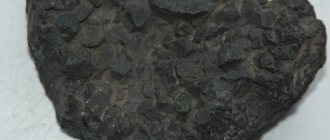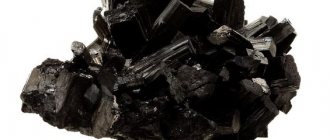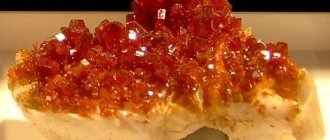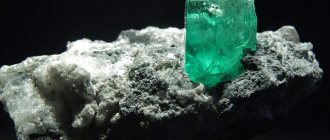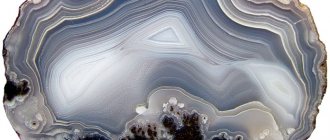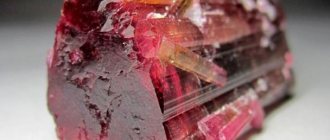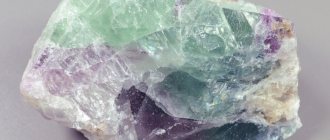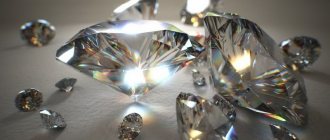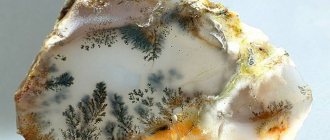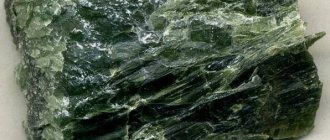Muscovite is a layered potassium silicate that belongs to the group of micas and is more commonly seen in the form of colorless white crystals. Sometimes, taking into account additional impurities, the mineral has a green, yellow, pinkish or brown tint. The muscovite stone has healing, magical properties, and also affects various signs of the Zodiac.
Muscovite: is it mica or a mineral?
Muscovite mica The earth hides many minerals.
They all differ in composition, shape, properties, color and application. According to the rarity of the finds, they are valuable or of industrial importance. One of the most common crystals in the depths of the earth is muscovite.
Muscovite is a plate-like crystal, the most common on earth.
Muscovite belongs to the group of micas and the subclass of silicates (layered).
Emergence
There are a number of methods for the appearance of muscovite:
Magical emergence. The mineral is found in vein layers of igneous origin. And this is by no means formed in the flowing layers. Subsequently, the freezing of medium and acidic magmas accentuates the mineral. It is considered a rock-forming component of some of the upper layers (roughly granite). Then the mineral begins to spread throughout the entire space of the pegmatite (the reproduction sphere of the “main” layer) or is folded into a nest (they can reach 1.5-2 m).
Metamorphic emergence. With an intrusive combination (mineral concentration of high igneous layers formed in the depths of the earth's strata) and upper layers.
In layered clays and clayey sediments. They arrive there as a result of the formation of extinction. Under the influence of wind, small inclusions of muscovite in exposed areas exfoliate and disintegrate into small particles. If the disappearance is chemical, the mineral can switch to other substances.
Muscovite: history of the name of mica
Muscovite photo
According to archaeological excavations, muscovite was actively used back in the 11th century in the territory of the city of Novgorod.
Mica, the second name for muscovite, quickly spread to Muscovy, where window glass was made from it.
By the 16th century, muscovite was actively sold outside the state.
Mica from Rus' beyond the territory of Muscovy began to be called Russian glass, and later the name was generally shortened to the word “muscovite”.
Mica became widely popular in the 16th century. By the end of the 17th century, muscovite mining stopped abruptly due to the spread of window glass.
In the middle of the 20th century, the progressive development of technologies in the field of instrument making, electrical industry, and computer technology gave impetus to the use of muscovite in a different capacity.
It began to be actively used as a type of insulating material in most mechanisms and devices.
Stone products
Muscovite is used for jewelry. Bracelets, beads, pendants, earrings, rings, and rings are made with gemstones. Leather, wood, jewelry alloy or precious metal are used for the frame.
They wear jewelry with clothes whose style is in harmony with the design of the product. They are not worn in the gym, on the beach, in the pool, or in the sauna. Clean with water and a soft brush. Store in a fabric bag or case.
A raw mineral measuring 3–5 cm costs from $2. Collectible samples of muscovite paired with another gem are sold for 2,000–120,000 rubles. Prices for jewelry range from 20–200 euros/1 item.
How to care for a mineral
Products made from mica are quite fragile, so they must be protected from impacts and friction. It is better to store jewelry in separate boxes with a soft backing. Do not get it wet or leave it in the bath or damp places. To remove dirt, wipe with a damp cloth and immediately blot with a paper napkin. Dust is brushed off with a synthetic broom.
Description of muscovite
Muscovite mineral photo
The mineral is very common in the soil. It is a rock-forming element in igneous rocks, sedimentary and metamorphic.
Its mass fraction is up to 4% of the total soil, which indicates significant reserves of the mineral.
For industry, large crystals are used, and they are much less common.
Crystal sizes range from 1 cm² or less to specimens as large as 1 m².
Muscovite comes in many color varieties.
The mineral is a crystal with many layers of plates, tightly or loosely adjacent to each other.
The plates are elastic and quite flexible. With their help, magnificent patterns in the form of flowers are formed on minerals.
Without impurities, muscovite has a transparent color.
Basically it has some shade and color depending on the location and the constituent chemical elements of the rock:
- white;
- lactic;
- grey;
- silver;
- brownish;
- pale green;
- yellowish;
- red;
- green.
The most common specimens are gray, white and milky in color. Gems like to be found in muscovite deposits.
Based on transparency they are divided into:
- transparent;
- translucent.
Based on brilliance they are divided into:
- silky;
- glass;
- mother-of-pearl.
Many photos depict bizarre shapes, colors, patterns that attract the eye with their uniqueness, transparency and brilliance.
Disadvantages of the breed
As mentioned earlier, mica is a mineral that can impart significant strength to a material. However, despite its highly valued properties of versatility and practicality, this rock is characterized by porosity and fragility. That is why mica is used exclusively in combination with other components that can provide the material with solidity and mechanical strength. The presence of this mineral in rocks reduces their durability and strength, making grinding and polishing difficult.
Properties of muscovite
Features corresponding to this type of minerals lie in the structure of crystal irregularities.
The unevenness of the outer part of the material fully corresponds to the unevenness inside it.
The smoother the material, without chips, with the least number of plates, the better quality it is.
Electrical insulation is the main ability of this mineral.
The main property of mica is its high electrical insulation - the ability not to conduct current and prevent the penetration of environmental conditions.
The reflection spectrum of muscovite, which shows the energy of reflection, is also important.
The material has excellent ductility and flexibility. Its density is 2.83 g/cm³.
It is practically not subject to melting, which shows resistance to high temperatures.
Recognition of muscovite occurs due to its pearlescent luster, detachment of thin silver plates, velvety shine, elasticity, pleasant light tones of translucent white, cream, gray and yellow.
Varieties of muscovite
Muscovite mineral photo
Muscovite crystals have many names:
- cat silver;
- potassium mica;
- Moscow star;
- butcheporitis;
- Shernikit.
According to variety, muscovite is divided into:
- alurgite - contains a significant amount of Mn;
- fuchsite - rich green color, contains Cr, is quite rare in nature;
- phengite is a material with a high Si content;
- sericite - a material with thin granular plates with an insignificant K2O content;
- mariposite - contains a significant amount of Cr.
Form of being in nature
The appearance of crystals . Regular tabular or lamellar, pseudohexagonal or diamond-shaped. Sometimes individuals with a columnar-pyramidal appearance are observed. The lateral edges are usually heavily streaked in horizontal directions.
Twins are common according to the mica law, rare according to the chlorite law.
Aggregates. Muscovite can also occur in continuous leafy-granular or scaly masses. Occasionally there are clusters of spherulites and kidney-shaped masses with concentric shell-like individuality. Solid, dense, hidden-scale masses with a silky sheen, sometimes difficult to recognize even under a microscope, are called sericite.
Chemical composition and properties of muscovite with formula
Muscovite mineral photo
Acids have virtually no effect on mica.
Muscovite belongs to the group of micas and the subclass of silicates (layered).
The chemical formula of muscovite is KAl2[AlSi3O10] [OH]2.
The composition includes potassium and aluminum oxide, silicon, water, chromium.
Aluminum oxides account for almost 39%, and silicon dioxide more than 45%.
It also contains small amounts of more than 30 chemical elements. The presence and quantity of these elements forms the variety of crystals.
The hardness of muscovite is negligible; on the scale of hardness and ability to withstand the penetration of another element without significant destruction, it occupies only 2-3 position. These numbers indicate the fragility of the material.
Who is suitable according to their zodiac sign?
Despite its peace-loving nature, mica is not recommended to be worn in jewelry or used as amulets for Sagittarius, Aries, Libra and Capricorn . Muscovite will only strengthen the negative character traits of the sign’s representative, making him aggressive or stubborn and stupid.
For Scorpio, Pisces, Aquarius and Virgo, muscovite will become a reliable assistant in creating a family and will enhance inspiration and peace.
Muscovite has a good influence on Leo, Cancer, Taurus and Gemini - as an amulet, mica will reveal the talents of representatives of these signs, enhance friendliness and nobility.
Thermal stability, thermal conductivity of muscovite
The cat silver mineral is resistant to high temperatures. It operates freely at temperatures of 600–700 degrees Celsius.
At a temperature of 800 degrees, swelling and discoloration of the substance occurs.
The stones are characterized by excellent thermal conductivity due to the specific placement of the crystal plates.
In horizontal and perpendicular positions, thermal conductivity will be varied, it can differ by 6 times.
Physical research methods
Differential thermal analysis . The DTA curve of muscovite shows three endothermic peaks at temperatures around 125, 860 and 1180° and one exothermic at 377°; the latter is caused by the oxidation of divalent iron.
Main lines on X-ray diffraction patterns : 10.04(10) - 5.02(5) - 4.48(6) - 4.46(5) - 3.35(10) - 2.56(8) (muscovite 2M1) ; 10.08(10) - 4.49(8) - 3.36(10) - 3.07(5) - 2.58(5) - 2.56(8) (muscovite 1M); 9.99(10) - 4.99(8) - 3.33(10) - 2.56(5) (muscovite 3T).
Ancient methods. It melts with difficulty under a blowpipe; in this case, a gray or yellow glass pearl is formed - white enamel. Water begins to be released only at a red-hot temperature (above 850 °C).
Interference coloring of muscovite in thin section
Area of application of muscovite
All varieties of muscovite are used in many industries and wherever production is associated with electronics.
High-grade and large crystals are used as an insulating material for parts that conduct current and operate at elevated temperatures: capacitors, various radio components, elements of computer, audio and video equipment, radio tubes and many other components.
Smaller muscovite crystals are used to produce paints and insulating materials called micanites, which are based on a layer of cat silver.
It is also actively used in the manufacture of costume jewelry and various artificial stones, gift products.
Beneficial Use
The main areas of use of muscovite are mechanical engineering, radio electronics and electronics industry.
There are a number of important alternatives for the use of solids.
Insulator (the mineral has excellent electrical insulating properties). For this case, flat mica is used. Depending on the volume of the plates, their color and additives in the solid, they are used in the formation of electric lamps, kerosene, mica glasses, steam generators or telephone sets.
Mica powder is used for making fire extinguisher, refractory structures, fireproof paints and clay makings. It is also used for the production of mica cardboard, wallpaper, explosive elements, used transmission products and others. The pigment is made from pieces of flat mica.
Formation of blanks. Approximately mikanit. Made from crushed remains of flat mica, muscovite products, already used and other micaceous remains. The method of making micanite involves joining individual pieces of shellac and compressing them under enormous pressure.
Quality of muscovite mineral
A stone with a smooth surface, without damage, holes, or chips is a high quality product. Unfortunately, there are very few such crystals, and their price is quite high.
The quality of the material depends on the depth and number of cracks on the surface, waviness, the content of additional chemical elements and holes.
The better the quality of the stone, the higher its price.
Holes can be solid or not continuous, cracks can be small or deep; splintering - deep cut-out stripes - can lead to complete unsuitability of the stone.
Additionally, the included elements that determine the color of the crystals are not always suitable as an insulating material.
For example, if the composition contains iron or its compounds, naturally, the iron will conduct current.
Difference from a diamond
Moissanite is distinguished by its unique play of reflections on its edges. Considering that its characteristics are not inferior to those of diamond, it has turned out to be a real treasure for the jewelry industry. The price of an artificial stone is significantly lower than a diamond, but it is very difficult to distinguish it.
There are various methods to verify the authenticity of diamonds:
- Electronic tester. The device is equipped with a screen with an arrow and a special probe, which is brought to the stone. During diagnostics, the electrical and thermal conductivity of the gem is measured. The needle of the device will accurately show the nature of the mineral and reveal its true origin.
- Visual determination of the birefringence effect characteristic of moissanite.
- Using an ultraviolet lamp. In its rays, carborundum acquires a slight yellow or green fluorescence.
- Recognition of the specific gravity of a mineral using special liquids. For diamond and carborundum, these meanings are different, and an experienced jeweler will be able to establish the truth if the gem is not set in a precious metal.
There are also traditional methods to distinguish a diamond from moissanite. If you breathe on a stone and it does not become cloudy and remains crystal clear, then it is a diamond. Moisture does not linger on its surface and quickly evaporates. If carborundum is brought to an open flame, it will acquire a greenish tint. The changes will be irreversible, and the cost of the stone will decrease significantly.
But when buying in a jewelry store, it is better to take the advice of an independent jeweler or reliable testing. Moissanite will not lose its value for many years and will remain the best of the artificially grown minerals.
Muscovite deposits
Muscovite is mined in loose rock deposits, sedimentary rocks:
- arkozakhah;
- sandstones;
- clayey shales;
- greywackah.
The most famous mining sites are:
- Ural, Siberia;
- India, Madras state;
- USA, North Carolina;
- Australia;
- Canada;
- Norway;
- Germany, Fichtel mountains;
- Brazil;
- France.
The healing properties of muscovite
Muscovite has a healing effect on the endocrine system.
There is an opinion among traditional healers that muscovite is able to heal wounds, cleanse the skin of acne, pimples and rashes, and various skin diseases.
There is an assumption about the positive effect of Moscow glass on the human endocrine system.
If you wear any cat silver jewelry in the form of necklaces, beads, bracelets, you can prevent thyroid diseases.
The magical qualities of muscovite
The magical qualities of muscovite stone. People have long believed that the color scheme of crystals affects certain parts of the soul and protects a person from various dangers:
- The Moscow star of yellow, milky and brown shades is capable of attracting success in any monetary transactions and financial endeavors.
- The green shade reveals all the delights of the soul: care, balance, calmness and good nature.
- Pink shades saturate the heart with tender feelings, harmony and love.
For good health, a cat silver stone can be worn daily by all people, except those who are very passionate by nature or too balanced.
